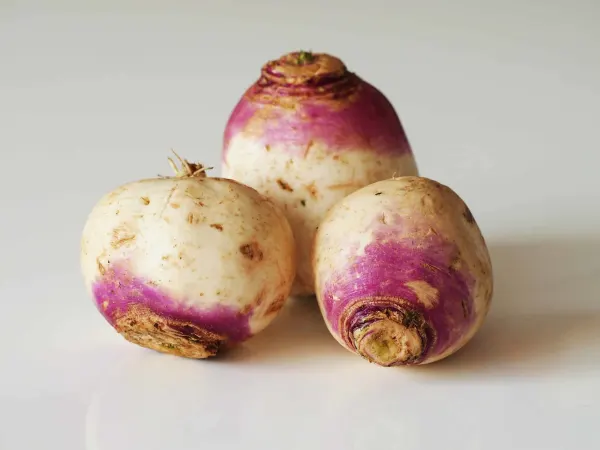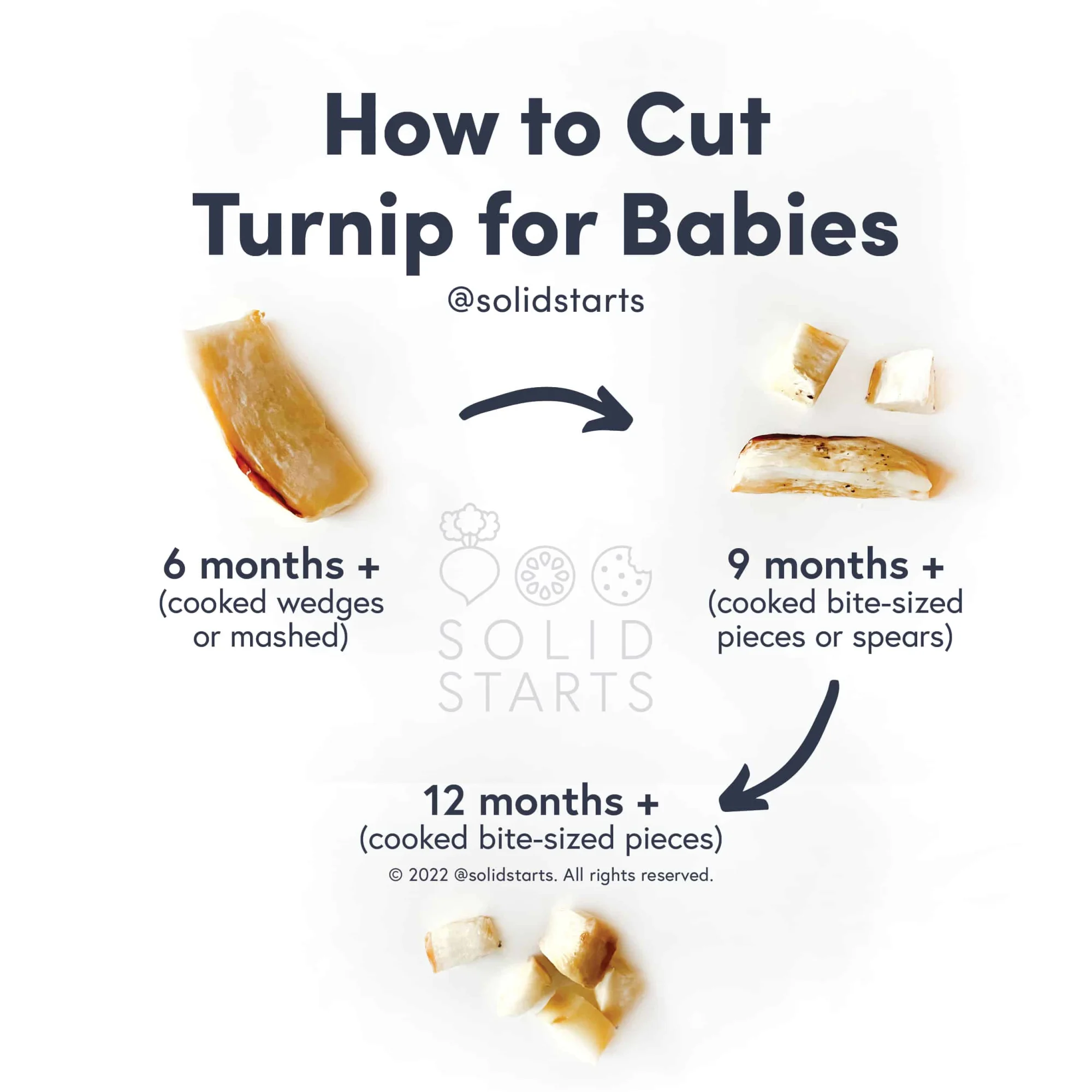Access our First Foods® Database in the Solid Starts App.
Learn moreTurnip
Vegetable
Age Suggestion
6 months
Iron-Rich
No
Common Allergen
No

When can babies eat turnips?
Turnips (and turnip greens) may be introduced as soon as baby is ready to start solids, which is generally around 6 months old.
How do you prepare turnips for babies with baby-led weaning?
Every baby develops on their own timeline, and the suggestions on how to cut or prepare particular foods are generalizations for a broad audience.
6 to 8 months:
Offer large wedges of turnip that have been cooked until soft for baby to grab and munch on. Alternatively, serve mashed turnip that baby can scoop with hands. Mashed turnip also works well as a base for iron-rich grains, legumes, and seeds that are hard for baby to scoop up, like amaranth, lentils, and quinoa. The mashed turnip acts as a binder for these foods, making it easier for baby self-feed while minimizing the mess. Turnip leaves are edible, too—if you’d like to serve them, finely chop the cooked greens and stir them into the mashed root or another soft, scoopable food like yogurt.
9 to 11 months old:
Serve cooked, soft turnip that has been cut into bite-sized pieces (about the size of a large adult knuckle). If you’d like to continue to offer large wedges, by all means do so. Larger pieces will provide baby with the opportunity to practice taking accurate sized bites.
12 to 24 months old:
Continue to offer cooked, bite-sized pieces of turnip, either on their own or as part of a dish. You can also continue to serve large, cooked wedges or use the mashed cooked root in bean patties, dumplings, fritters, meatballs, and pancakes. Once a toddler shows the ability to bite and tear with the teeth and/or gums, you can serve raw turnip root grated or cut into paper-thin slices.
Babies love variety just like adults do. Get more dinner ideas from our guide, 100 Dinners for Babies & Toddlers.
Videos
Are turnips a common choking hazard for babies?
Yes, raw or undercooked turnip’s firm texture does pose a choking risk, as it is difficult to chew and break down. To reduce the risk, cook turnip root until soft and mince or finely chop cooked turnip greens. As always, make sure you create a safe eating environment and stay within an arm’s reach of your baby during meals. For more information on choking, visit our sections on gagging and choking and familiarize yourself with the list of common choking hazards.
Is turnip a common allergen?
No. Allergies to turnips are uncommon, but have been reported. Information on turnip allergies is limited, however turnips are part of the cruciferous vegetable family and individuals who are allergic or sensitive to other members of the cruciferous family, such as mustard greens and broccoli, could theoretically be sensitive to turnips as well. Turnip allergy may also be more common in individuals who have an existing latex allergy.
As you would when introducing any new food, start by offering a small quantity for the first few servings. If there is no adverse reaction, gradually increase the quantity over future meals.
Are turnips healthy for babies?
Yes. Turnip root is a good source of fiber to support gut health, plant-based omega-3 fatty acids to support the brain, and B vitamins, especially vitamin B6, which perform hundreds of functions in the body. Turnip root contains special compounds called glucosinolates, which offer a host of benefits to the human body, including anti-cancerous properties. Purple turnip varieties offer the benefit of extra antioxidants.
While the root is more commonly eaten than turnip greens, the greens are packed with nutrition, including vitamin A, which is critical for eye, skin, and immune health, and folate, an essential nutrient for DNA and protein function. The greens are also good sources of fiber, B vitamins, vitamin E, zinc, calcium, and plenty of phytonutrients that support baby’s overall health.
★Tip: When shopping for turnips, buy both the root and greens, when possible. Use the greens first, as they will wilt within a few days. Roots save in the fridge or a cool, dark place for much longer.
Can turnips help babies poop?
Yes. Turnip offers good amounts of both soluble and insoluble fibers, as well as some glucosinolates and phenolic compounds. Together, these components contribute to overall digestive health and bowel regularity. Raffinose, a natural sugar and possible prebiotic found in turnips, may cause gas in some individuals, so consider offering smaller quantities of turnip initially and gradually increasing portions over time. Note that pooping patterns can vary significantly from child to child. Be sure to talk to your pediatric healthcare provider if you have concerns about baby’s pooping and digestive function.
Where do turnips come from?
Turnip’s bulbous roots and peppery greens have nourished humans since ancient times, when people in Central Asia learned to cultivate the wild plant. Over time, human migration and trade led to the development of related vegetables like bok choy, broccoli rabe, napa cabbage, rutabaga, and many more whose cultural significance is as diverse as the plant family. The roots appear in European heraldry. The greens offer simple nourishment during Nanakusa no Sekku (Festival of Seven Herbs) in Japan. And in African American foodways, turnips are a key ingredient in soul food recipes shared over generations.
What are recipe ideas for turnip?
To preserve turnip’s nutrients, steam or sauté the root instead of boiling or blanching. From there, you can mash the root with butter or cream for baby, then add maple syrup or miso before serving adults and older children. Alternatively, cut the root into wedges to make turnip fries then roast them in olive oil and your family’s favorite spices. Stew turnip with meats like beef, lamb, or pork to let the vegetable soak up their hearty flavor. Don’t toss the greens—they taste delicious braised with bacon, chopped up with herbs to make turnip top salsa verde, or sauteed in oil and topped with an egg. Want to keep it simple? Try pairing apples and turnips: the sweetness of the fruit balances any earthy bitterness in the root.
Our Team
Written by
Expert Tips Delivered to Your Inbox
Sign up for weekly tips, recipes and more!
Copyright © 2025 • Solid Starts Inc







